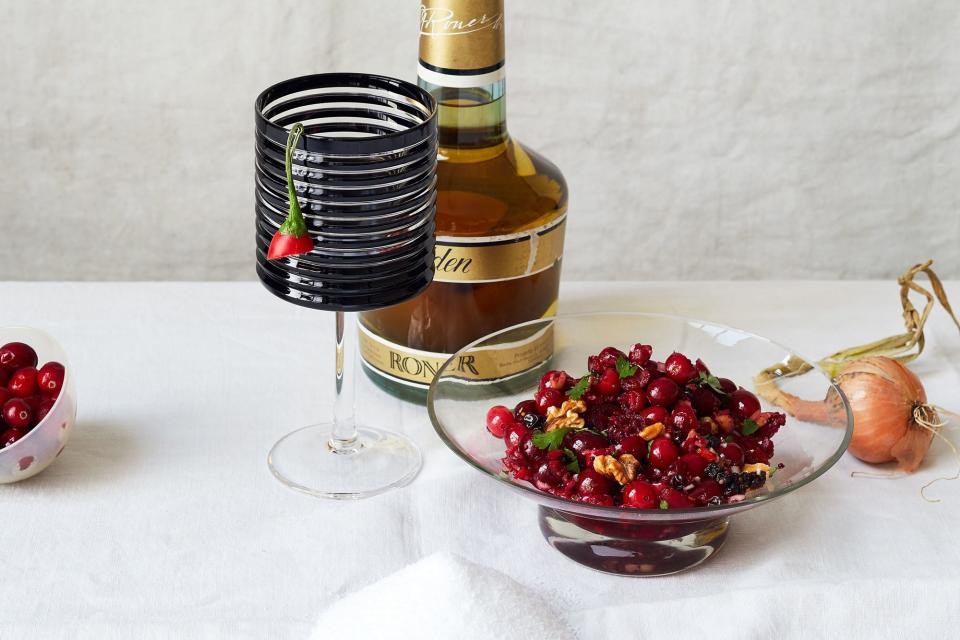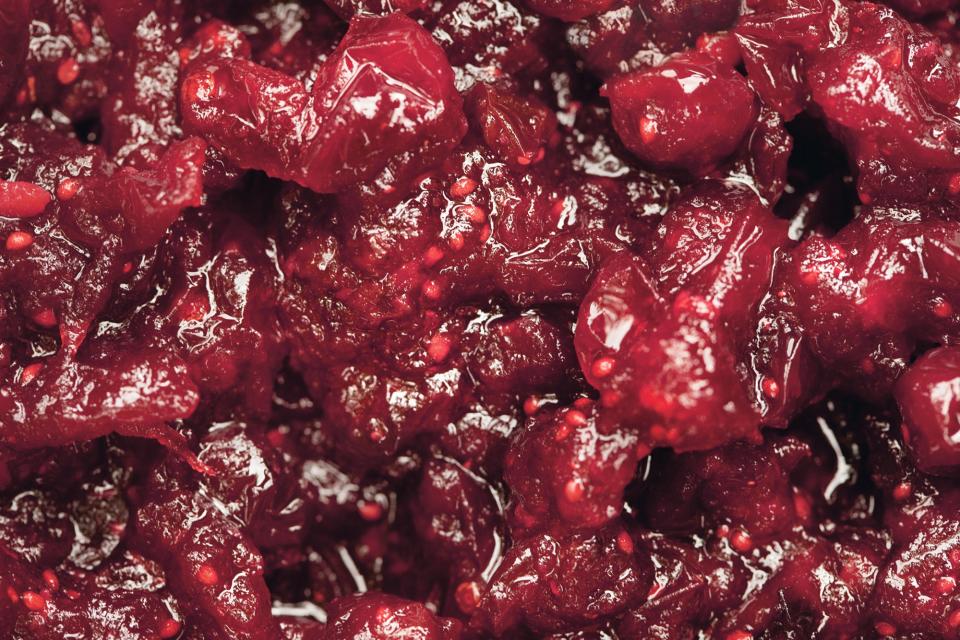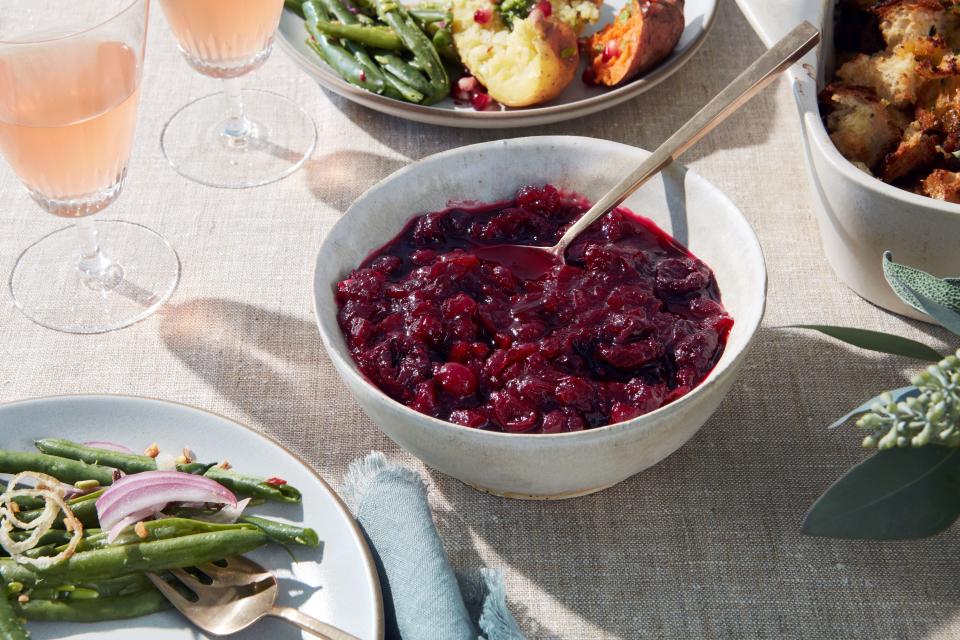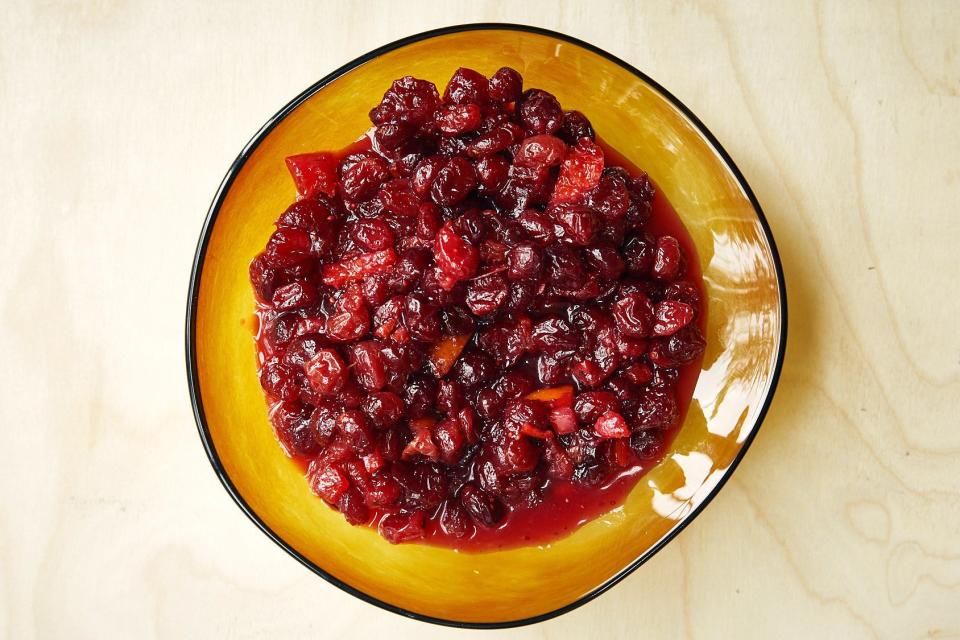Thanksgiving Cranberry Sauce: Everything You Need to Know
For some people, making cranberry sauce for Thanksgiving is as simple as popping the top off a can. Others spend weeks thinking about alternative flavors, fruits, and spices to add into the homemade mix. I am not here to sway you one way or the other; I'm just here to help answer all the questions that might come up on this journey toward understanding one another.
How Do I Pick Out Fresh Cranberries?
Look for firm berries with no soft spots. If there are any squishy or brown berries, remove them from the rest and discard. Color isn't an indication of ripeness, but generally lighter red berries have more thickening power and darker berries will be juicier. If you're buying bags of berries, you may want to grab an extra in case some of the berries need to be tossed in the compost.
'Tis the season...to hoard cranberries in your freezer.
How Much Cranberry Sauce Do I Need Per Person?
If you're making fresh cranberry sauce, plan on at least 1/4 cup per person—more if your family really likes cranberry sauce. I usually make about 1/2 cup per person and find I have plenty left over for a few days of slathering cranberry sauce over everything.
So how many bags of cranberries should you buy? One 12-ounce bag of cranberries makes about 2 1/4 cups of basic cranberry sauce—in my house, that's enough for about five people.
Going the canned route? You'll need at least one can for six people.
How Far Ahead Can I Make Fresh Cranberry Sauce?
You can make cranberry sauce up to three months ahead and store it in the freezer (defrost overnight in the fridge), or you can make it up to a week ahead and keep refrigerated until Thanksgiving.

Cranberry and Walnut Relish
What's the Difference Between Cranberry Sauce and Cranberry Relish?
Typically, "cranberry sauce" refers to a cooked product while "cranberry relish" is uncooked (the cranberries instead are broken down in a food processor or other manner)—however, some recipes use these phrases interchangeably. Other names you might see:
Cranberry Chutney: Typically a chunkier sauce containing a secondary fruit (apples, raisins, pineapples, chopped citrus peel) and often ginger. Chutney recipes may include extra spices: cinnamon, mustard seed, coriander, fennel seed, sometimes borrowed from the South Asian pantry. Chutneys often straddle the line between sweet and savory by including shallots or onions and sometimes fresh herbs.
Cranberry Compote: While the whole cooked fruit in cranberry sauce may or may not be strained out, a compote definitely has large pieces of fruit in it and likely has a higher fruit-to-sauciness ratio than a typical sauce.
Cranberry Conserve: Another chunky variation, conserve is not unlike chutney in that it will likely have a secondary fruit and maybe some nuts. The spices, however, will usually be more subdued.
Cranberry Jelly: A cooked product that may or may not be set with gelatin. Either way, it has a jiggly texture and has been strained of all solid bits.
Cranberry Salsa: Just as chutney may indicate an Indian-ish flavor profile, salsa likely indicates a Mexican or Latin American flavor profile. Expect cilantro, onions, chiles, and lime juice, among other ingredients you'd find in the pantheon of salsa variations.

Chipotle Cranberry Sauce
What's the Simplest Homemade Cranberry Sauce Recipe?
Ready? In a saucepan, combine 1 cup fresh or frozen cranberries, 1/3 cup sugar, 1/3 cup water, and 1 pinch of kosher salt (or scale up to one 12-ounce bag of cranberries, 1 cup sugar, 1 cup water, and 1/2 teaspoon kosher salt). Bring to a boil, stirring occasionally. Reduce heat to a low boil and cook for 10 minutes, until the berries have all burst. Remove from heat. Serve warm, room temperature, or chilled. Cranberry sauce will thicken as it cools.
To store, let cool completely, then transfer to a resealable container and refrigerate for up to 1 week or freeze for up to 3 months.
But How Do I Make the Best Cranberry Sauce?
There's nothing wrong with basic sauce, but this is where you can play to your own preferences. Riff on the directions above, but instead of using water, use orange juice, apple juice, cherry juice, or even ginger ale. Substitute about 1/4 of the liquid with dry white wine or sherry. Add in fresh citrus zest or spices like cinnamon, allspice, or black pepper. Instead of white sugar, use maple syrup or demerara sugar. Or, if you're too nervous to get improvisational, choose from any of our favorite cranberry sauce recipes below:
Can I Use Frozen Cranberries?
Sure. If your sauce is cooked, frozen will work just as well as fresh. Keep them frozen until you're ready to cook and toss them into the pot straight from the freezer, no thawing required. For an uncooked relish or salsa, use fresh cranberries.

Thanksgiving Menu 2019 - Cranberry-Cherry Compote - RECIPE - v2
Is Cranberry Sauce Served Warm or Cold?
Cranberry sauce is best served at room temperature or slightly chilled. (You've got enough things on the menu to warm up! Don't make the list longer!) I tend to make cranberry sauce a few days before Thanksgiving and then set it on the table about an hour or two before we plan to eat.
Can I Make Cranberry Sauce Without Sugar?
Cranberries are inherently bitter and tart. Besides balancing those attributes, sugar is essential in getting cranberry sauce to reach a jam-like texture. Which means that making cranberry sauce without any sugar is a dicey game.
If you're trying to avoid white sugar, opt for a recipe that uses honey. If you'd like to reduce your sugar intake, look for recipes that go in a more savory direction like this relish with walnuts and Fresno chiles or this sauce which relies on caramelized shallots for some of its sweetness. Be careful when using sugar substitutes, as some of them have a bitter aftertaste.

Roasted Sweet Potato and Squash Rounds with Cranberry Agrodolce
How Do You Thicken Cranberry Sauce?
Cranberries are very high in pectin, which is only activated once the berries have burst and the sauce boils. As long as it's cooked long enough, the sauce will thicken as it cools. If you find that your sauce is runnier than you'd like after it cools, you can return it to a sauce pan, bring it back to a boil, and simmer to reduce some of the liquid.
Does Cranberry Sauce Need to Be Refrigerated?
Canned cranberry sauce can be kept in the pantry until after it's opened—but feel free to store it in the fridge if you like a chilled sauce and magically have extra fridge space.
Freshly made sauce should be refrigerated. Let cool to room temperature before transferring to a resealable container. If you're making cranberry sauce on Thanksgiving day, it can be held at room temperature until dinner time.

Cranberry Sauce with Orange and Cinnamon
Can I Freeze Cranberry Sauce?
Yes! Cranberry sauce can be frozen for up to three months. Thaw in refrigerator overnight before serving.
How Do I Make Cranberry Jelly From Scratch?
You can make cranberry jelly with any of the flavorings mentioned above, but there is one critical step: you have to strain your sauce after it cooks. To ensure your cranberry jelly gets nice and jiggly, measure your strained liquid. For every cup of liquid, measure out 1 1/2 teaspoons powdered gelatin and sprinkle it over 1/4 cup cold water. Let sit for 5 minutes to bloom gelatin. Pour some of your cranberry liquid back into the saucepan, add bloomed gelatin mix, and bring to a simmer. Stir until gelatin is completely dissolved and strain back into remaining cranberry liquid. Stir to combine, then pour liquid jelly into a greased mold (or a cleaned out tomato can if you want to fool your canned-cranberries-only family into eating homemade sauce). Chill at least 12 hours before serving.
Why Is My Canned Cranberry Sauce Upside Down?
Many brands affix labels to what would appear to be upside-down cans. But really, the can is designed slightly differently than, say, canned beans, in order to account for an air bubble that forms when the can is filled and sealed. To open, turn the can so the label's words are upside down, then use a can opener to remove the side facing you. (Some cans have a rounded lip and a stamp saying "open other end" on one side. Do as the stamp commands.)
How Do I Get Cranberry Jelly Out of the Can in One Piece?
For best results, chill canned cranberry jelly overnight. After opening the can (see above), run a butter knife all the way around between the jelly and the can. Invert a small plate onto the open side of the can and flip the whole thing over. Lift the can. If jelly doesn't dislodge immediately, a few swift shakes should do the trick.
How Can I Make Canned Cranberry Jelly Look Nice?
For some people Thanksgiving is all about that perfect disc of cranberry jelly. To serve it any other way than simply sliced is seen as a personal attack on their holiday.
But, if you want more than a log of red jelly and butter knife on your table, you could cut the jelly into half-inch-thick discs and lay them out on a platter (or two platters), overlapping slightly. Combine something to top it with: orange zest, thyme, and a bit of sugar perhaps; or walnuts and candied ginger. Select two or three complementary ingredients, chop them finely and then sprinkle over the top of the cranberry discs.
If you don't care about your Thanksgiving companions' feelings, go ahead and spoon the jelly into bowl and break it up lightly with a fork or serving spoon. Garnish optional.

Thanksgiving Skillet Pizza
What Can I Do With Leftover Cranberry Sauce?
Use it as a sandwich spread on turkey sandwiches, ham sandwiches, and PBJ. Use it to dress a roasted squash and potato side dish. Add a few tablespoons to a vinaigrette. Serve it on a cheeseboard at your holiday party. Thin it out to use as a glaze for meatballs. Stir some into yogurt for breakfast. Use it as a condiment for pan-seared pork chops.
What's an Alternative to Cranberry Sauce?
What do you mean you "just don't like cranberries!?" JK. I'm not here to shame anyone. If your family isn't down with America's native berry, but you still want something to contrast the richer dishes on the table, opt for another jam-like condiment: this ginger-shallot marmalade would be ideal.
For something with more texture and brightness, this citrus-pomegranate relish offers those same tart flavors. If you're not at all into sweet condiments, make an herby green sauce and call it a day.
Originally Appeared on Epicurious


